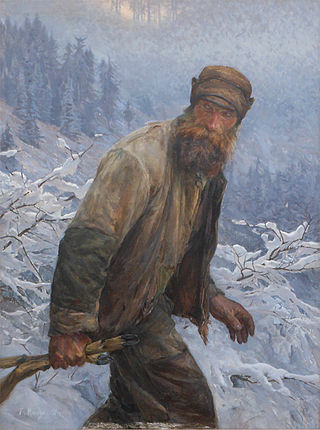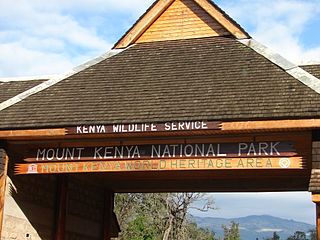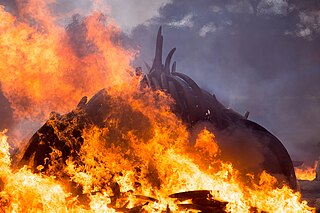
Poaching is the illegal hunting or capturing of wild animals, usually associated with land use rights. Poaching was once performed by impoverished peasants for subsistence purposes and to supplement meager diets. It was set against the hunting privileges of nobility and territorial rulers.

Garamba National Park is a national park in the north-eastern Democratic Republic of the Congo covering nearly 5,200 km2 (2,000 sq mi). It is among Africa's oldest parks and was designated a World Heritage Site by UNESCO in 1980 for its protection of critical habitat for northern white rhinoceroses, African elephants, hippopotamuses, and giraffes. Garamba National Park has been managed by African Parks in partnership with the Institut Congolais pour la Conservation de la Nature since 2005.

The International Fund for Animal Welfare (IFAW) is one of the largest animal welfare and conservation charities in the world. The organization works to rescue individual animals, safeguard populations, preserve habitat, and advocate for greater protections. Brian Davies founded IFAW. IFAW was instrumental in ending the commercial seal hunt in Canada. In 1983 Europe banned all whitecoat harp seals products. This ban helped save over 1 million seals. IFAW operates in over 40 countries.

Environmental issues in Kenya include deforestation, soil erosion, desertification, water shortage and degraded water quality, flooding, poaching, and domestic and industrial pollution.

Wildlife trade refers to the products that are derived from non-domesticated animals or plants usually extracted from their natural environment or raised under controlled conditions. It can involve the trade of living or dead individuals, tissues such as skins, bones or meat, or other products. Legal wildlife trade is regulated by the United Nations' Convention on International Trade in Endangered Species of Wild Fauna and Flora (CITES), which currently has 184 member countries called Parties. Illegal wildlife trade is widespread and constitutes one of the major illegal economic activities, comparable to the traffic of drugs and weapons.

Kenya Wildlife Service (KWS) is a state corporation under the Ministry of Tourism and Wildlife established by an act of Parliament; Wildlife Conservation and Management Act CAP 376, of 1989, now repealed and replaced by the Wildlife Conservation and Management Act, 2013. At independence, the Government of Kenya committed itself to conserving wildlife for posterity with all the means at its disposal, including the places animals lived, forests and water catchment areas.
The Boni National Reserve is a national reserve for conservation and lies in the Garissa County, Kenya. The reserve covers an area of 1,339 km2 (517 sq mi) and is managed by Kenya Wildlife Service. It was gazetted in 1976 as a dry season sanctuary for elephants in the former Kenyan Ijara, and Lamu districts and Somalia. The elephant population has been greatly reduced by poaching.

Iain Douglas-Hamilton is a Scottish zoologist from Oxford University and one of the world's foremost authorities on the African elephant. In 1993, he founded Save the Elephants, which is dedicated to securing a future for elephants and their habitats.
Esmond Bradley Martin was an American conservationist who fought for both the preservation of elephants against the illegal ivory trade, and for the rhinoceros against the illegal trade of rhinoceros horns. A trained geographer, Martin was considered a world-renowned expert in the ivory trade and rhinoceros horn trade. He had been a special envoy of the United Nations for the conservation of rhinoceros. Militant for a reduction in the demand for ivory to dry up the market, he participated notably in the stop of rhinoceros horn trade to China in 1993 and ivory in 2017.

The ivory trade is the commercial, often illegal trade in the ivory tusks of the hippopotamus, walrus, narwhal, black and white rhinos, mammoth, and most commonly, African and Asian elephants.

Elephant hunting, which used to be an accepted activity in Kenya, was banned in 1973, as was the ivory trade. Kenya pioneered the destruction of ivory as a way to combat this black market.

The Sheldrick Wildlife Trust (SWT) operates an orphaned elephant rescue and wildlife rehabilitation program in Nairobi, Kenya. It was founded in 1977 by Dame Daphne Sheldrick to honour her late husband, David. Since 2001, it has been run by their daughter, Angela.

On 21 September 2013, four masked gunmen attacked the Westgate shopping mall, an upmarket mall in Nairobi, Kenya. There are conflicting reports about the number killed in the attack, since part of the mall collapsed due to a fire that started during the siege. The attack resulted in 71 total deaths, including 62 civilians, five Kenyan soldiers, and all four gunmen. Approximately 200 people were wounded in the massacre.
Jim Justus Nyamu, of Nairobi, Kenya, is an elephant research scientist and activist against poaching and trade in ivory. Nyamu is the executive director at the Elephant Neighbors Center (ENC) and is leader of the movement, Ivory Belongs to Elephants. He has also held positions at the African Conservation Centre and Kenya Wildlife Service. The ENC is a grass-roots collaborative and participatory research organization focused on enhancing the capacity of communities living with wildlife to promote interlinkages between species and their habitats.
Care for the Wild International is an animal charity, a non-governmental organization established in 1984 and based in the United Kingdom. It supports wildlife projects and it campaigns on animal rights issues in Britain and around the world.

Satao was one of Kenya's largest African elephants. He was known as a tusker because his tusks were so long that they almost touched the ground. The Tsavo Trust announced that Satao was killed by poachers using a poisoned arrow on 30 May 2014.

World Elephant Day is an international annual event on August 12, dedicated to the preservation and protection of the world's elephants. Conceived in 2011 by Canadian filmmakers Patricia Sims and Michael Clark of Canazwest Pictures, and Sivaporn Dardarananda, Secretary-General of the Elephant Reintroduction Foundation in Thailand, it was officially founded, supported and launched by Patricia Sims and the Elephant Reintroduction Foundation on August 12, 2012. Since that time, Patricia Sims continues to lead, support and direct World Elephant Day, which is now recognized and celebrated by over 100 wildlife organizations and many individuals in countries across the globe.

The destruction of ivory is a technique used by governments and conservation groups to deter the poaching of elephants for their tusks and to suppress the illegal ivory trade. As of 2016, more than 263 tonnes (580,000 lb) of ivory have been destroyed, typically by burning or crushing, in these high-profile events in 21 countries around the world. Kenya held the first event in 1989, as well as the largest event in 2016, when a total of 105 tonnes (231,000 lb) of ivory were incinerated.

The Ivory Game is a 2016 American documentary film, directed by Kief Davidson and Richard Ladkani. The film examines the ivory trade, which has become a global concern, pitting governments and environmental preservationalists against poachers and Chinese ivory merchants.
The Elephant Action League (EAL) is an environmental non-governmental organization founded in 2013 in the United States by Andrea Crosta, Gilda Moratti, and Francesco Rocca. EAL is based in Los Angeles, California.















